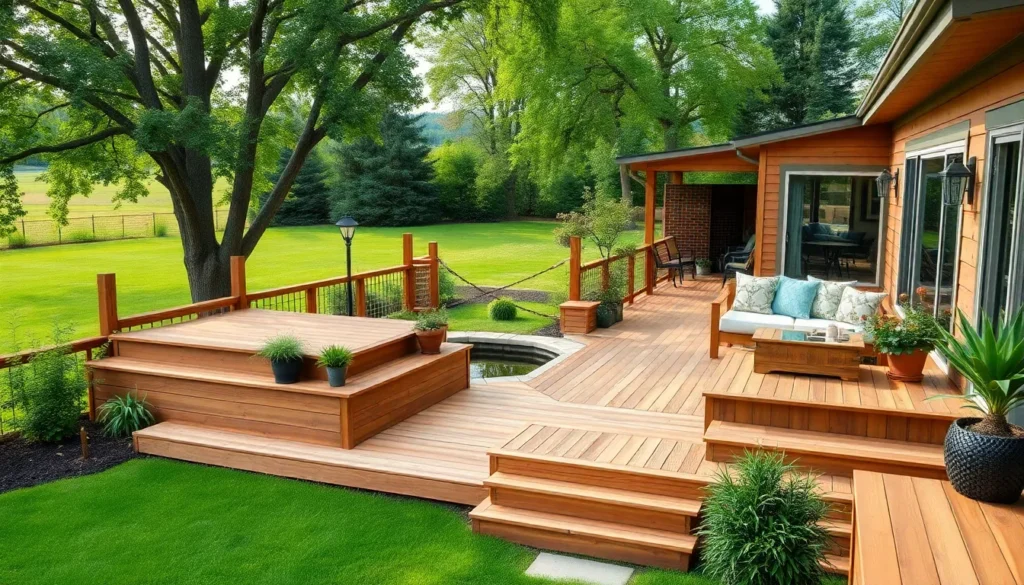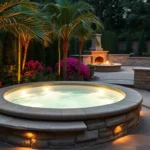Transform your outdoor space into a stunning retreat with the perfect garden decking solution. We’ve discovered that well-designed decking doesn’t just add value to your property—it creates an entirely new living area where memories are made and relaxation becomes second nature.
Whether you’re working with a compact city garden or sprawling countryside views, the right decking ideas can revolutionize how you experience your outdoor space. From sleek modern platforms that complement contemporary homes to rustic wooden walkways that blend seamlessly with natural landscapes, we’ll explore options that fit every style and budget.
The beauty of garden decking lies in its versatility and immediate impact. We’re here to guide you through innovative designs that maximize your space while creating the perfect foundation for outdoor dining, entertaining, or simply enjoying your morning coffee surrounded by nature.
Create a Multi-Level Deck Design for Visual Interest
Multi-level decking transforms flat outdoor spaces into ever-changing architectural features that captivate attention and maximize functionality. We can achieve stunning visual depth by strategically varying elevation throughout our garden deck design.
Incorporate Different Deck Heights
Elevating sections of your deck creates natural boundaries and adds architectural dimension to any garden space. We recommend using height variations of 12 to 18 inches between levels to maintain comfortable access while creating distinct visual separation. Split level designs work particularly well for sloped gardens where we can follow the natural contours of the land.
Platform heights should serve practical purposes beyond aesthetics. We suggest raising dining areas 6 to 8 inches above lounging spaces to create intimate conversation zones. Upper levels provide excellent vantage points for garden views while lower sections feel more grounded and private.
Connecting different heights requires careful planning of transitions. We install wide steps between levels using the same decking material to maintain design continuity. Built in benches along level changes serve dual purposes as seating and safety barriers.
Add Built-In Planters Between Levels
Integrated planters between deck levels soften hard edges while introducing natural elements. We design these features using matching materials like composite lumber or treated timber to blend seamlessly with the decking structure. Planters measuring 18 to 24 inches wide provide adequate soil depth for most garden plants.
Strategic placement of planters creates privacy screens and defines separate areas. We position tall plantings with ornamental grasses or shrubs between dining and relaxation zones. Herb gardens in accessible planters near kitchen access points combine functionality with fresh aromatics.
Drainage systems in built in planters protect both plants and deck structure. We install proper waterproofing beneath planter boxes and include drainage holes that direct water away from deck supports. Raised planter designs prevent water pooling while making plant maintenance easier.
Design Separate Zones for Different Activities
Distinct activity zones on multi-level decks maximize outdoor living potential throughout the day. We create cooking areas on stable lower levels to accommodate heavy grills and prep surfaces safely. Elevated relaxation zones with comfortable seating arrangements capture better views and evening breezes.
Size requirements vary significantly between different deck zone functions. We allocate minimum 8 by 10 feet for dining areas to accommodate tables and chair movement. Entertainment zones need approximately 12 by 16 feet to handle larger gatherings comfortably.
Traffic flow between zones requires thoughtful pathway planning. We design clear sight lines and wide walkways measuring at least 36 inches between activity areas. Corner connections work better than central pathways for maintaining zone privacy while ensuring safe movement.
Choose the Right Decking Materials for Your Garden Style
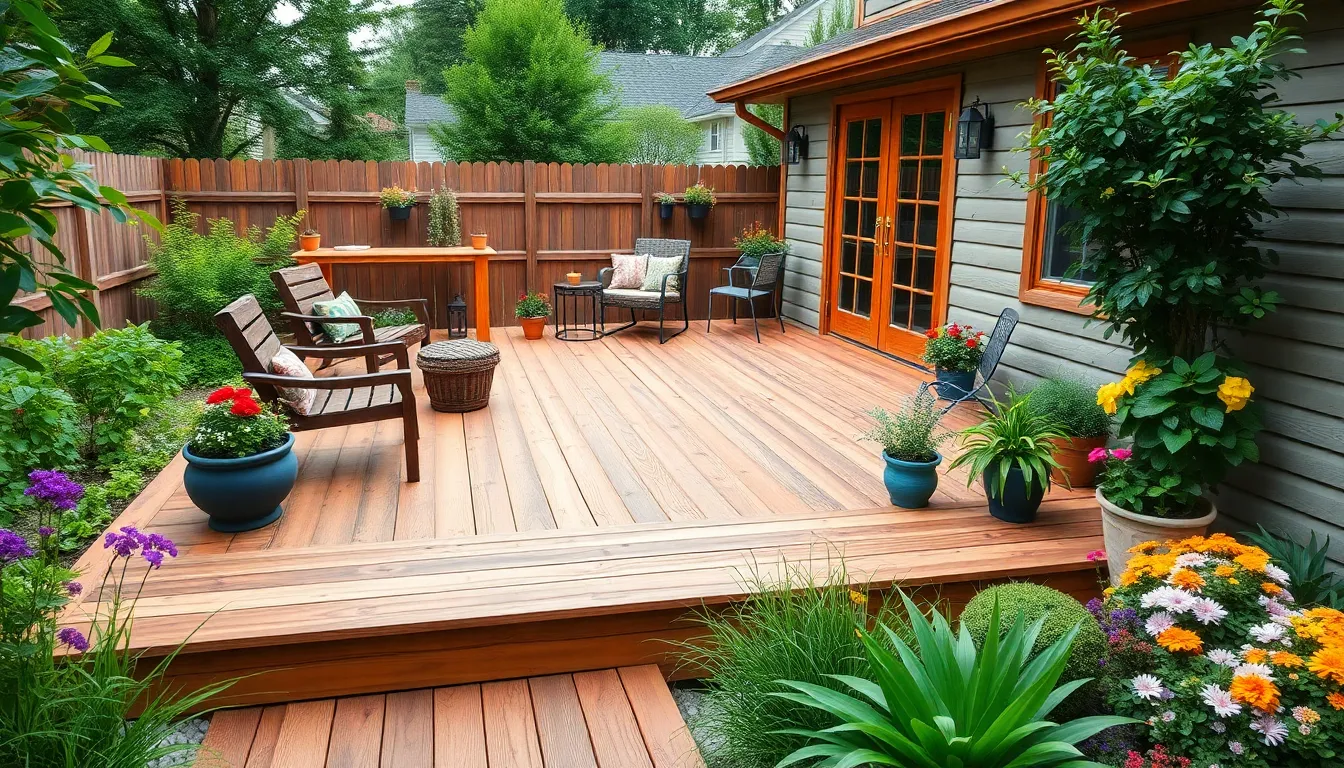
Selecting the perfect decking material determines both the aesthetic appeal and long-term functionality of your outdoor space. Material choices directly impact maintenance requirements, durability, and overall garden design cohesion.
Consider Composite Decking for Low Maintenance
Composite decking delivers exceptional resistance to weathering, rotting, splintering, and insect damage, making it our top recommendation for busy homeowners. Manufacturing processes combine recycled wood fibers with plastic polymers to create boards that withstand harsh weather conditions without constant upkeep.
Investment costs run higher initially, but composite materials generate long-term savings through reduced maintenance expenses. Weather resistance means you won’t need regular staining, sealing, or replacing damaged boards like traditional wood options require.
Eco-friendly manufacturing uses recycled materials, reducing environmental impact while providing a sustainable outdoor solution. Durability extends decades beyond natural wood alternatives, delivering consistent performance across various climate conditions.
Explore Natural Wood Options for Warmth
Natural wood brings timeless beauty and organic warmth that perfectly complements garden landscapes. Cedar stands out as our preferred lightweight option, offering natural decay resistance through built-in tannins that protect against moisture damage.
Working with cedar proves remarkably easy due to its lightweight properties and straightforward installation process. Weather exposure transforms cedar into an elegant soft gray tone that blends seamlessly with garden foliage and outdoor furniture.
Exotic hardwoods like Ipe and Brazilian Walnut provide superior durability with exceptional resistance to termites and decay. Premium options require higher investment and regular maintenance but reward homeowners with unmatched longevity and sophisticated appearance.
Mataverde FSC Machiche decking offers high-density construction that naturally resists shrinking and insect damage. Sophisticated aesthetics make this option ideal for upscale garden designs requiring premium materials.
Investigate Eco-Friendly Bamboo Alternatives
Bamboo represents a rapidly renewable resource that regenerates faster than traditional hardwoods, making it an environmentally conscious choice. Lightweight construction simplifies installation while maintaining impressive durability standards.
Pest resistance naturally protects bamboo decking from common outdoor threats without chemical treatments. Decay resistance ensures long-lasting performance in various weather conditions, though availability remains more limited than conventional materials.
Sustainability credentials make bamboo appealing to environmentally minded homeowners seeking green building answers. Growth rates exceed traditional wood sources by important margins, supporting responsible forestry practices.
Design Around Existing Garden Features
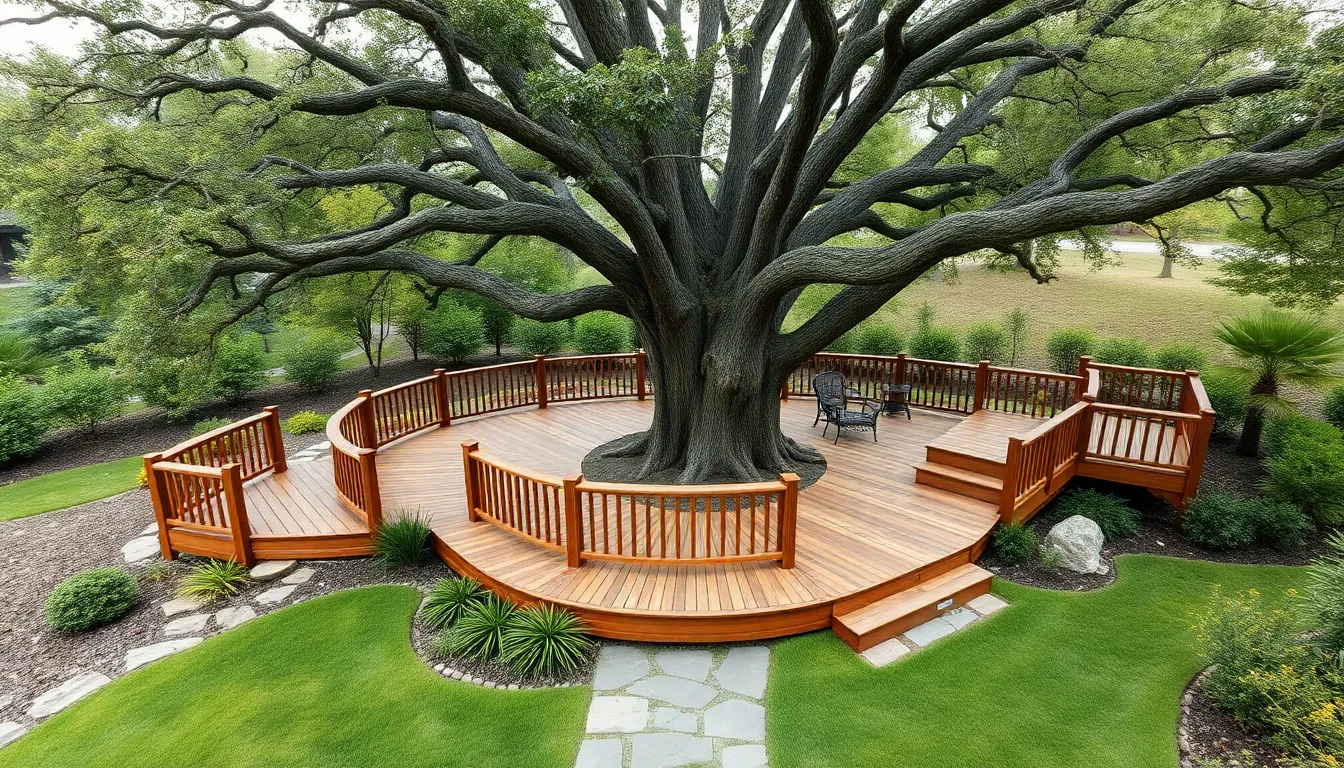
Smart decking design respects and enhances your garden’s natural character. We can transform existing industry elements into stunning focal points that define our outdoor living space.
Build Around Mature Trees and Plants
Design decking to encircle or complement mature trees and plants for maximum visual impact and environmental harmony. We preserve the integrity of established vegetation while creating intimate outdoor spaces that feel naturally integrated.
Consider these tree-friendly approaches:
- Circle large oak trees with curved deck sections that follow the natural canopy line
- Create viewing platforms around specimen plants like Japanese maples or flowering shrubs
- Install removable deck panels near growing trees to accommodate future root expansion
- Position deck railings to frame attractive plantings and create natural privacy screens
Incorporate garden features by using decking to surround ponds water features or other focal points throughout your industry. This strategy creates cohesive outdoor rooms that feel purposefully designed rather than randomly placed.
Incorporate Natural Stone Elements
Combine decking with stone to add texture and visual weight to your garden design. We can use natural stone pathways to connect deck areas or create attractive borders that ground the structure in its environment.
Effective stone and deck combinations include:
- Flagstone walkways leading to elevated deck platforms
- River rock borders defining deck perimeters
- Stacked stone retaining walls supporting raised decking areas
- Natural boulder accents placed strategically around deck corners
Stone and decking patterns create unique textures by alternating materials in geometric or organic arrangements. We achieve sophisticated designs that blend hardscape elements seamlessly with wooden deck surfaces.
Work with Your Garden’s Natural Slope
Raised decking for slopes transforms challenging terrain into usable outdoor living space. We can create level entertaining areas in gardens with uneven or sloping ground while maintaining the natural grade beneath the structure.
Multi-level decks follow natural contours to establish distinct activity zones at different elevations. We design deck systems with multiple levels that create separate areas for dining entertaining and quiet relaxation while maximizing views and functionality across sloped landscapes.
- Install stepped deck levels that mirror hillside gradients
- Use deck height variations to create natural sight lines and privacy zones
- Position upper deck levels to capture better views and breezes
- Connect different deck elevations with integrated stairs and landings
Add Built-In Seating and Storage Solutions
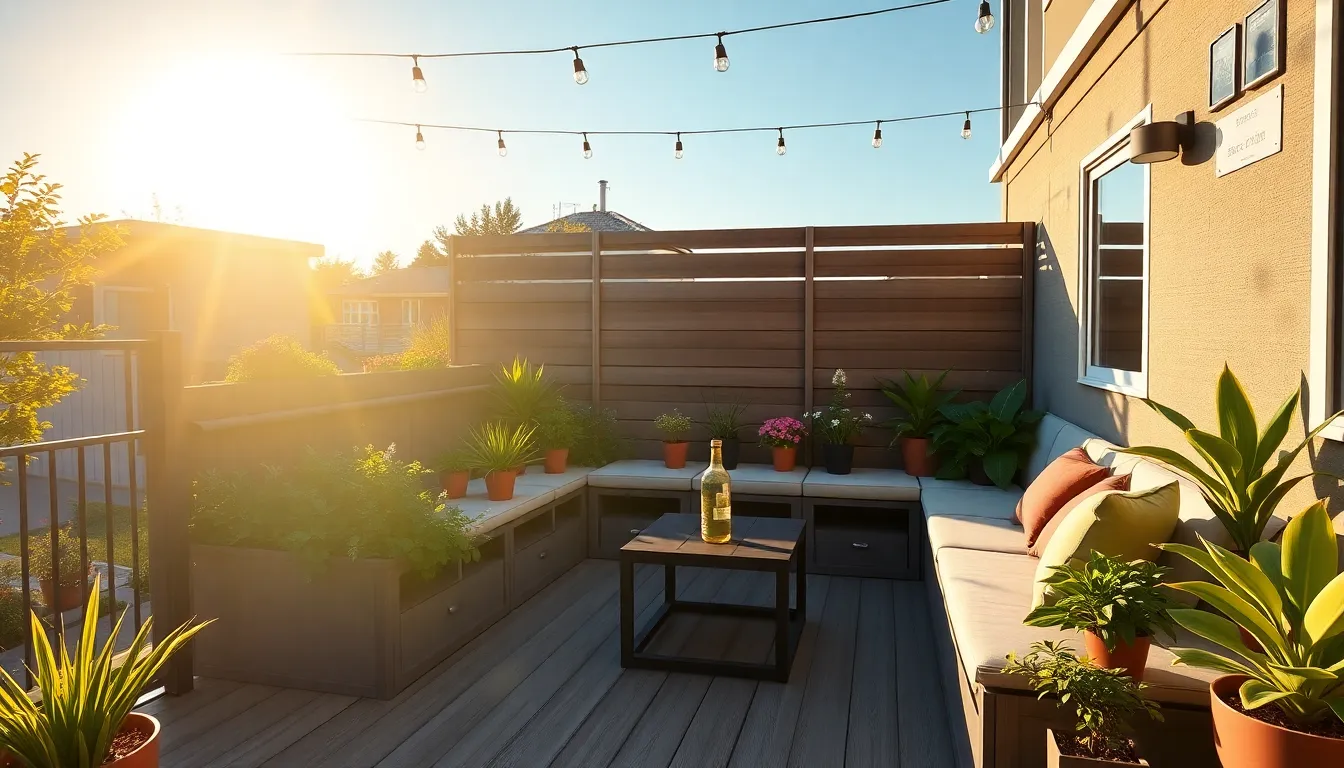
Smart built-in seating transforms garden decking into functional outdoor living spaces while solving storage challenges. These dual-purpose features maximize your deck’s potential without compromising valuable floor space.
Create Corner Bench Seating with Storage
Corner benches make efficient use of deck space while providing wraparound seating for gatherings. Position these L-shaped benches in deck corners to create intimate conversation areas that naturally define social zones. Built-in storage compartments underneath offer convenient hiding spots for outdoor cushions, gardening tools, and children’s toys.
Design your corner bench with lift-up seats that reveal weatherproof storage bins. Standard corner bench dimensions of 18-20 inches in height provide comfortable seating while ensuring easy access to stored items. Consider adding hinges to individual sections rather than one large lid to improve functionality and prevent strain when accessing stored goods.
Wraparound designs naturally encourage face-to-face conversation while maximizing seating capacity in compact areas. Install weather-resistant hardware and use marine-grade hinges to ensure your storage mechanisms withstand seasonal temperature changes and moisture exposure.
Install Deck Railings with Built-In Planters
Integrated planter benches combine safety railings with seating and greenery in one cohesive design. Mount planter boxes directly onto bench structures to create natural barriers that enhance privacy while adding visual appeal. Position these planter benches along deck perimeters to establish clear boundaries without blocking scenic views.
Raised troughs serve as backrests and planters simultaneously, creating comfortable seating with built-in garden features. Install these elevated planters at 32-36 inches high to meet safety requirements while providing adequate back support. Choose drought-resistant plants like ornamental grasses or succulents that thrive in contained environments.
Consider placing integrated planters at bench ends to frame seating areas with cascading plants or vertical gardens. These end-mounted planters soften hard edges while creating natural transitions between different deck zones.
Design Custom Storage Boxes as Seating
Bench chests offer hidden storage answers that double as extra seating when entertaining guests. Build these custom storage boxes from durable composite materials or cedar to match your existing deck aesthetics. Standard bench chest dimensions of 48 inches long by 18 inches wide provide seating for two adults while offering substantial storage capacity.
Install soft-close hinges to prevent lid slamming and add safety supports to hold lids open during use. Incorporate ventilation holes to prevent moisture buildup and mold formation inside storage compartments. Apply weatherproof sealants to all joints and hardware connections to ensure longevity.
Backless storage benches offer versatility in placement and usage, allowing you to position them wherever additional seating or storage is needed. These sleek designs maintain clean sight lines across your deck while providing practical answers for outdoor entertaining essentials.
Incorporate Lighting for Evening Garden Enjoyment
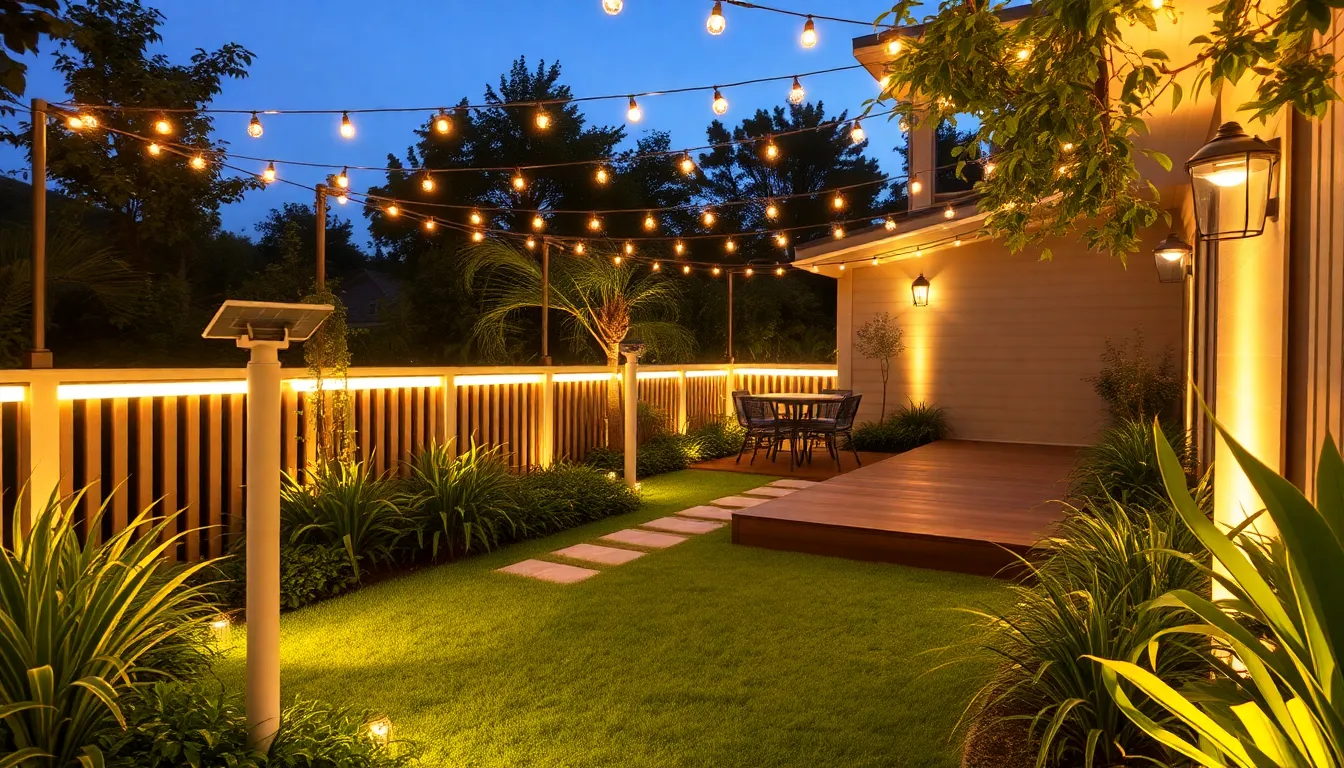
Transforming your garden deck into an enchanting evening retreat requires strategic lighting answers that enhance both safety and ambiance. We’ll explore three essential lighting approaches that create magical outdoor spaces perfect for nighttime gatherings and relaxation.
Install LED Strip Lighting Along Deck Edges
LED strip lights offer a modern, sleek approach to deck illumination that highlights architectural features while providing essential safety lighting. We recommend installing these energy-efficient strips under deck railings or along the perimeter edges to create clean lines that define your outdoor space. This placement ensures walkways remain well-lit, reducing trip hazards during evening activities.
These versatile lighting answers highlight the deck’s architectural design while consuming minimal electricity. Installing strips beneath handrails creates a floating effect that makes railings appear to glow softly in the darkness. We’ve found that cool white LEDs work best for contemporary designs, while warm white options complement traditional garden styles.
Add Solar-Powered Post Lights
Solar-powered post lights provide an eco-friendly lighting solution that eliminates the need for electrical wiring or ongoing energy costs. These self-contained units charge during daylight hours and automatically illuminate your deck space when darkness falls. We particularly appreciate their ease of installation, as they require no professional electrical work or trenching.
Post lights create warm, inviting pools of light that guide visitors safely through your garden deck area. Installing them at regular intervals along pathways and deck perimeters ensures consistent illumination throughout your outdoor space. Weather-resistant designs withstand seasonal changes while maintaining reliable performance year after year.
Create Ambient Lighting with String Lights
String lights transform ordinary deck spaces into magical evening entertainment areas with their festive, cozy atmosphere. We recommend hanging them from existing trees, pergola structures, or dedicated mounting points to create overhead canopies of warm light. This versatile lighting option adapts to various deck configurations and seasonal decorating themes.
These affordable lighting answers add instant charm to any garden deck while providing gentle illumination for dining and socializing. Installing dimmable string lights allows you to adjust brightness levels based on exact activities or moods. We suggest choosing LED string lights for their longevity and energy efficiency, especially for permanent installations that operate nightly.
Create Designated Outdoor Dining and Entertainment Areas
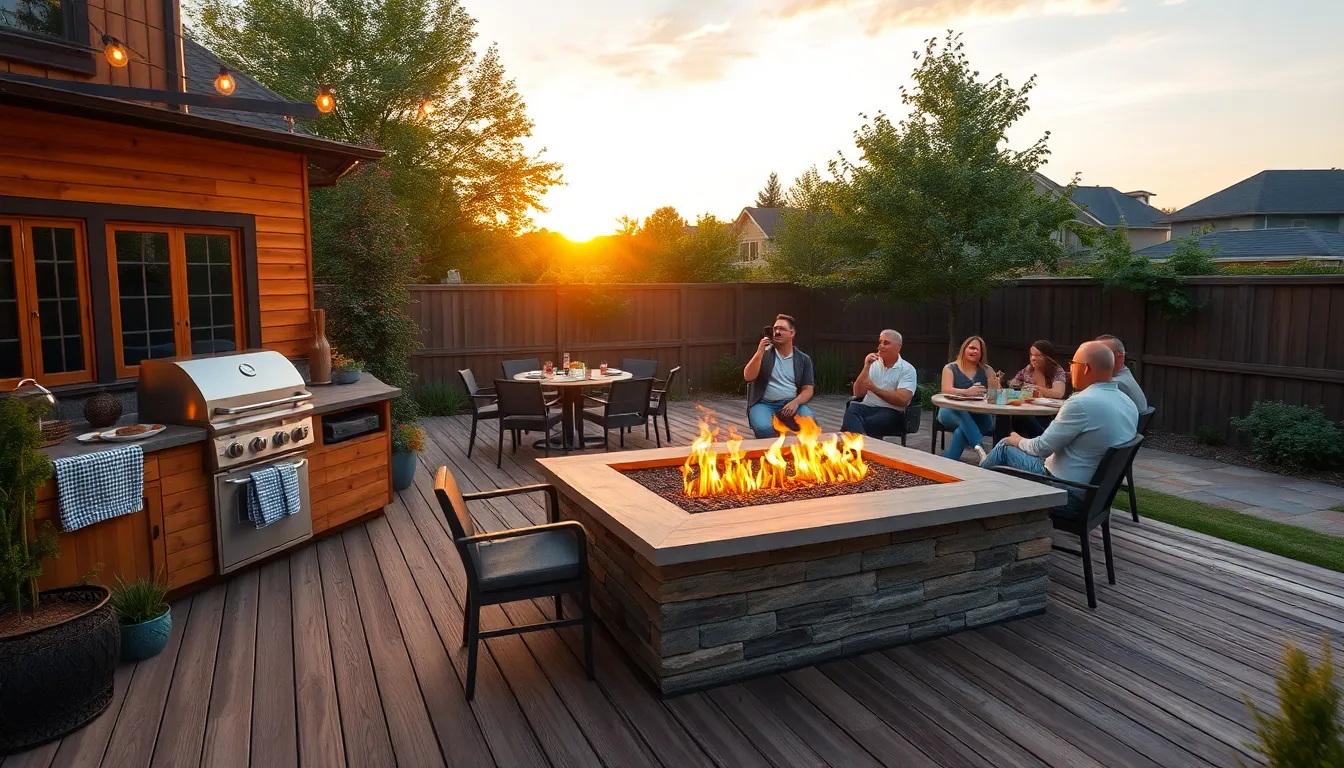
Converting your deck into a designated entertainment zone transforms outdoor living into an immersive experience. These specialized areas maximize functionality while creating seamless transitions between cooking, dining, and relaxation spaces.
Design a Built-In BBQ and Kitchen Station
Built-in outdoor kitchens integrate cooking facilities directly into your decking structure, eliminating the need to move between indoor and outdoor spaces during gatherings. We recommend incorporating a BBQ station with adjacent counter space for food preparation and serving, creating a functional workspace that keeps the chef engaged with guests.
Strategic placement of integrated storage beneath the deck provides convenient access to cooking utensils, supplies, and equipment without compromising the clean aesthetic of your outdoor kitchen. Cabinet systems designed for outdoor use protect items from weather while maintaining easy accessibility during cooking sessions.
Counter heights should match standard kitchen dimensions at 36 inches, ensuring comfortable food preparation and serving. Installing electrical outlets within the kitchen station powers small appliances and provides charging capabilities for devices, improving the overall functionality of your outdoor cooking space.
Add a Fire Pit or Outdoor Fireplace
Fire features create natural gathering points that extend the usability of your deck throughout cooler months and evening hours. Installing a fire pit or outdoor fireplace on your deck provides warmth and ambiance that draws people together for conversation and relaxation.
Seating arrangements around fire features should maintain 6 to 8 feet of clearance for safety while creating an intimate atmosphere for guests. We suggest incorporating built-in bench seating or designated furniture zones that face the fire element, encouraging natural conversation flow and comfortable viewing angles.
Safety considerations require proper ventilation and fire-resistant materials surrounding the installation area. Composite decking materials offer excellent heat resistance compared to traditional wood options, making them ideal choices for decks featuring fire elements.
Install Weather-Resistant Entertainment Centers
Weather-resistant entertainment systems bring indoor comfort to outdoor spaces, allowing extended use of your deck for gatherings and relaxation. Installing outdoor-rated TVs and speaker systems creates an all-weather entertainment environment that withstands rain, wind, and temperature fluctuations.
Mounting answers for outdoor electronics require weatherproof enclosures and proper cable management to prevent moisture damage. We recommend positioning entertainment centers with adequate shade coverage to improve screen visibility and protect equipment from direct sunlight exposure.
Lighting features enhance entertainment areas by providing adequate illumination for evening activities while creating welcoming atmospheres during gatherings. Strategic placement of outdoor lighting highlights architectural features of your deck design and ensures safe navigation during nighttime use.
Use Deck Railings as Design Features
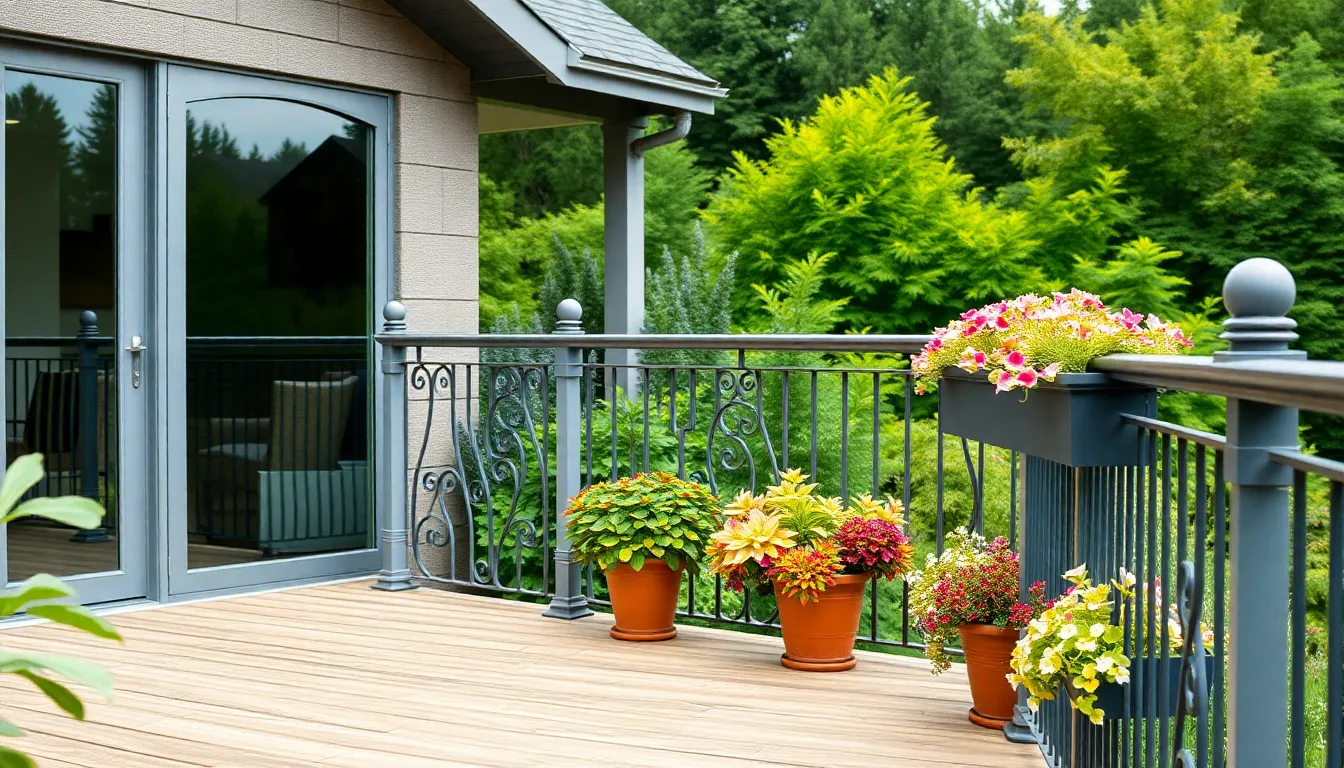
Transforming your deck railings from simple safety barriers into stunning design elements can dramatically enhance your garden’s visual appeal. These functional features offer endless opportunities to express your personal style while maintaining safety standards.
Install Glass Panels for Unobstructed Views
Glass panels create a seamless visual connection between your deck and garden, making your outdoor space feel larger and more open. We recommend using tempered safety glass that can withstand weather conditions while providing crystal-clear sightlines to your industry beyond.
Frameless glass systems offer the most minimalist appearance, virtually disappearing to showcase your garden’s natural beauty. These panels work exceptionally well for elevated decks where you want to preserve views of distant scenery or water features.
Framed glass options provide additional design flexibility with metal or wooden frames that can match your deck’s existing materials. Consider bronze or black aluminum frames for modern aesthetics, or choose wooden frames to complement traditional deck styles.
Installation requires professional expertise to ensure proper structural support and weatherproofing. Glass panels typically cost more upfront than traditional railings but deliver lasting value through their timeless appeal and minimal maintenance requirements.
Add Decorative Metal Balusters
Decorative metal balusters transform ordinary railings into architectural focal points that complement your garden’s character. We’ve seen homeowners achieve stunning results by mixing metal elements with wood or composite materials for unique visual contrast.
Wrought iron balusters offer classic elegance with intricate scrollwork and traditional patterns that suit cottage gardens and formal landscapes. These durable elements resist weathering and can be powder-coated in various colors to match your design scheme.
Contemporary steel designs feature clean lines and geometric patterns perfect for modern garden settings. Square or rectangular profiles create sophisticated looks, while twisted or curved elements add artistic flair without overwhelming the space.
Aluminum balusters provide lightweight durability with endless customization options including laser-cut patterns, powder-coated finishes, and integrated lighting features. These low-maintenance options resist corrosion and can incorporate your family initials or garden motifs.
Mixing materials creates visual interest by combining metal balusters with wooden handrails or glass panels. This approach allows you to achieve custom looks while staying within budget constraints.
Create Living Walls with Planter Railings
Planter railings integrate greenery directly into your deck’s structure, creating vertical gardens that enhance privacy while adding natural beauty. We recommend this approach for gardeners who want to maximize planting space without sacrificing deck area.
Built-in planter boxes can be constructed along railing tops using weather-resistant materials like cedar or composite lumber. These elevated gardens provide excellent drainage while creating natural barriers between your deck and neighboring properties.
Cascading plant selections work beautifully in planter railings, with trailing varieties like ivy, petunias, or trailing verbena spilling over edges to soften hard lines. Combine these with upright plants like ornamental grasses or small shrubs for varied textures and heights.
Irrigation considerations become essential for planter railings since elevated positions expose plants to more wind and sun. Install drip irrigation systems or self-watering planters to maintain consistent moisture levels without daily maintenance.
Seasonal flexibility allows you to change your planter railing displays throughout the year. Spring bulbs give way to summer annuals, followed by autumn mums and winter evergreens, keeping your deck visually captivating across all seasons.
Structural support must accommodate the additional weight of soil, plants, and water. Consult with deck professionals to ensure your railing system can handle planter loads safely.
Integrate Water Features into Your Deck Design
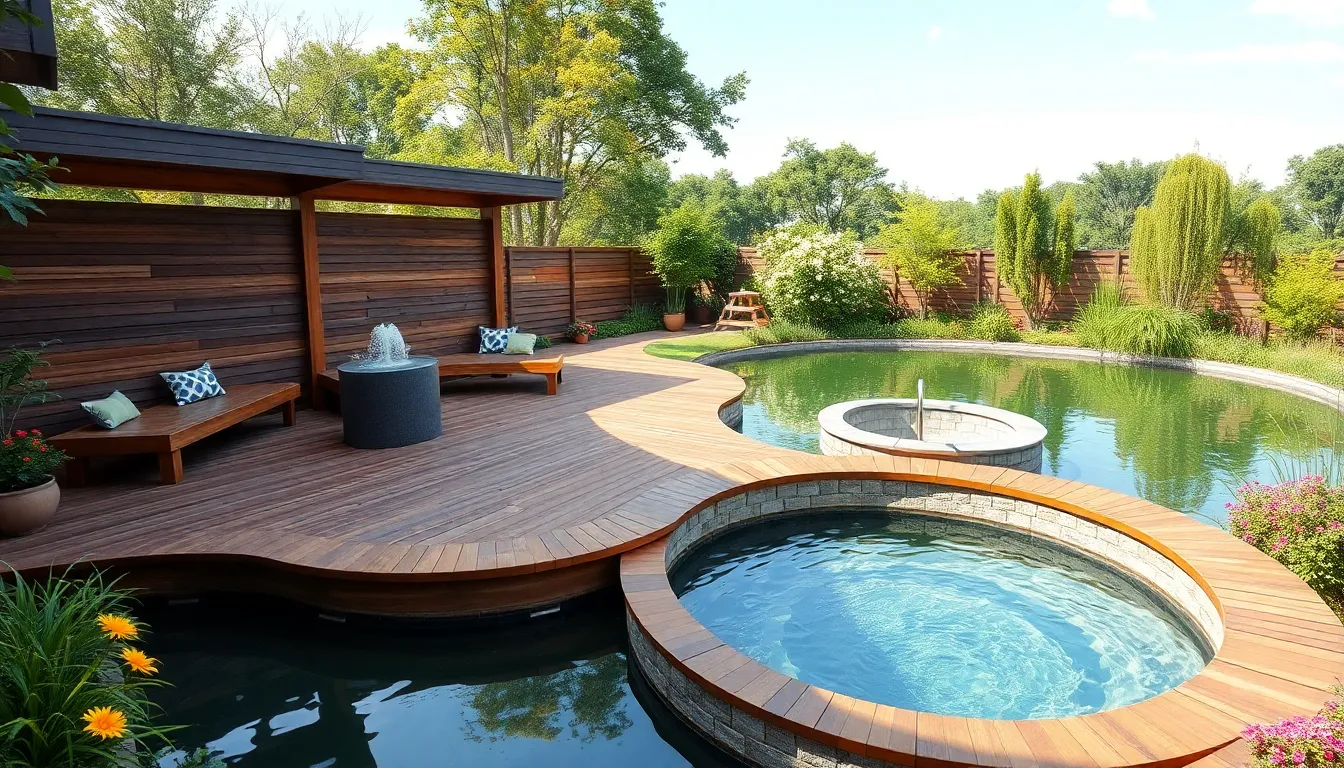
Water elements transform ordinary garden decking into tranquil retreats that engage multiple senses. Strategic placement of fountains, ponds, and spa features creates focal points that enhance both visual appeal and property value.
Build Around an Existing Garden Pond
Encircling your garden pond with decking creates a serene natural setting that maximizes waterfront access. We recommend designing curved or angular deck sections that follow the pond’s natural contours while maintaining safe distances from the water’s edge. Building platforms at varying heights around the pond establishes multiple viewing perspectives and creates intimate seating areas for quiet contemplation.
Incorporating built-in benches along the pond-side decking provides comfortable spots for watching fish or enjoying morning coffee. Safety railings become essential when decking extends close to water, but we suggest using glass panels or cable systems that maintain unobstructed pond views. Coordinating deck materials with existing pond features like stone edging or natural rock formations creates seamless integration that appears purposefully designed rather than added as an afterthought.
Add a Deck-Mounted Water Fountain
Installing a fountain directly on your deck surface creates a stunning focal point that adds soothing water sounds to outdoor gatherings. We recommend selecting fountains with self-contained water systems that don’t require permanent plumbing connections, making installation simpler and more flexible. Positioning the fountain at deck corners or along edges prevents water splash from reaching seating areas while maximizing visual impact.
Contemporary fountains with LED lighting systems extend enjoyment into evening hours and create dramatic effects against deck surfaces. Choosing fountain styles that complement your decking material ensures cohesive design, whether you select modern stainless steel features for composite decking or natural stone fountains for wooden platforms. Regular maintenance becomes straightforward with accessible pumps and filtration systems that keep water clean and circulation optimal.
Create a Hot Tub Integration Area
Designing decking around a hot tub transforms your outdoor space into a luxurious spa retreat that extends usability throughout the year. We suggest creating raised deck platforms that position the hot tub at comfortable entry height while providing surrounding space for towels, drinks, and relaxation accessories. Building privacy screens or pergola structures around the hot tub area establishes intimate boundaries without completely isolating the space from the main deck.
Incorporating built-in storage benches near the hot tub keeps towels and supplies easily accessible while maintaining clean sightlines. Planning electrical and plumbing access during the initial deck design phase prevents costly modifications later and ensures all connections meet safety codes. Strategic lighting placement around the hot tub area creates ambiance for evening soaks while providing adequate illumination for safe navigation between the spa and main deck areas.
Design Pergolas and Overhead Structures
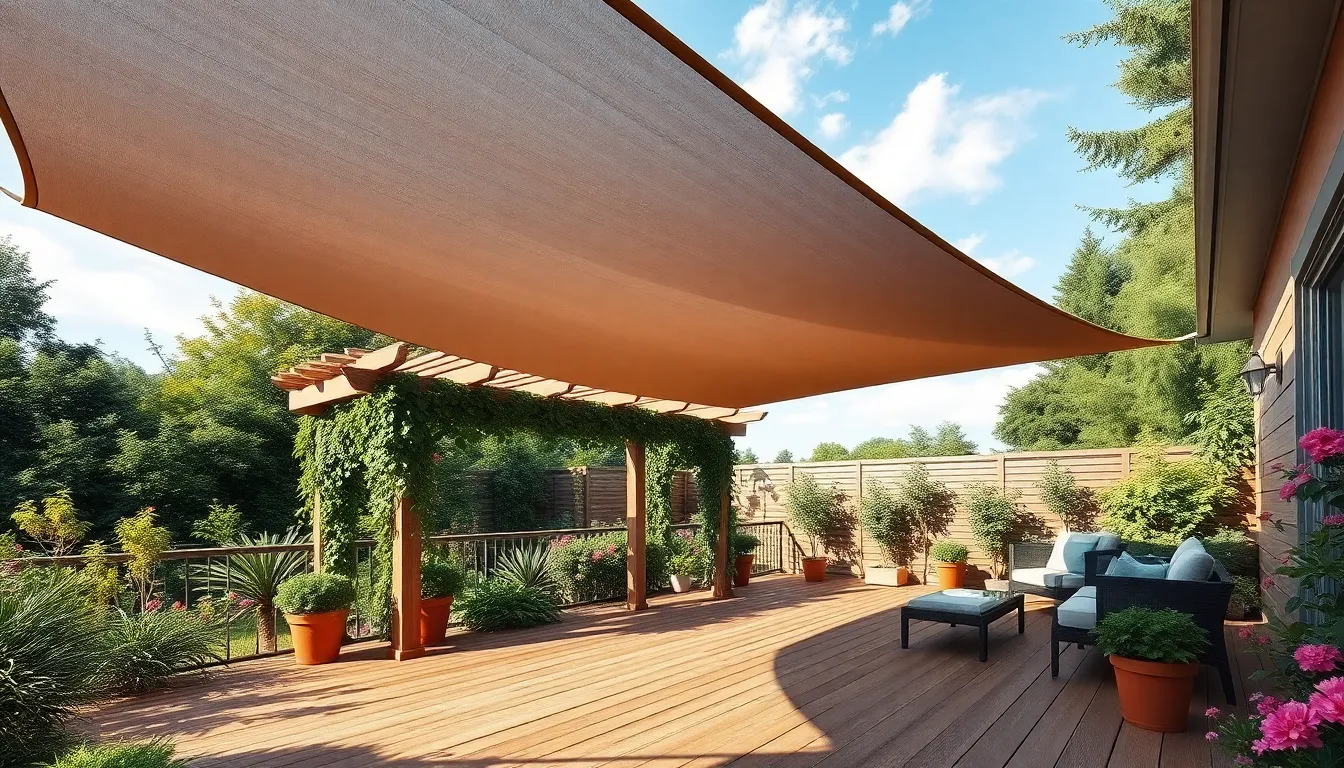
Overhead structures transform garden decking into comfortable outdoor rooms that provide essential shade and architectural interest. We’ll explore three versatile options that enhance both functionality and visual appeal.
Add a Retractable Awning System
Retractable awnings offer unmatched flexibility for your deck environment by allowing you to control sun exposure throughout the day. These systems extend when you need protection from harsh sunlight and retract completely when you want to enjoy open sky views. Modern motorized options include wind sensors that automatically retract the awning during storms, protecting your investment from weather damage.
Installation typically requires mounting brackets to your home’s exterior wall or deck posts. We recommend choosing waterproof fabrics in colors that complement your existing outdoor furniture and garden palette. Quality awnings provide UV protection ratings of 98% or higher while reducing deck surface temperatures by up to 15 degrees Fahrenheit.
Build a Traditional Wooden Pergola
Traditional wooden pergolas create timeless focal points that support climbing plants while defining outdoor living spaces. Cedar and pressure treated lumber remain popular choices due to their natural weather resistance and attractive grain patterns. Construction involves setting corner posts in concrete footings and connecting them with horizontal beams and cross rafters.
Spacing between rafters affects both shade density and plant growth potential. We suggest 12 to 18 inch spacing for moderate shade that allows dappled sunlight to filter through. Adding removable fabric panels or outdoor curtains increases privacy and weather protection when needed. Regular staining every 2 to 3 years maintains the wood’s appearance and extends structural life.
Install Modern Sail Shade Structures
Modern sail shade structures bring contemporary elegance to garden decking with their sleek geometric forms and high performance materials. These tensioned fabric systems create dramatic angular shadows while providing excellent UV protection and wind resistance. Installation requires anchor points at different heights to achieve proper tension and water runoff.
Triangle and square configurations work best for most deck layouts, with sizes ranging from 10 to 20 feet per side. Quality shade sails use HDPE fabric that blocks 90% to 95% of harmful UV rays while allowing air circulation to prevent heat buildup underneath. We recommend choosing neutral colors like sand or charcoal that coordinate with various decking materials and won’t fade quickly in direct sunlight.
Create Privacy Solutions with Your Decking
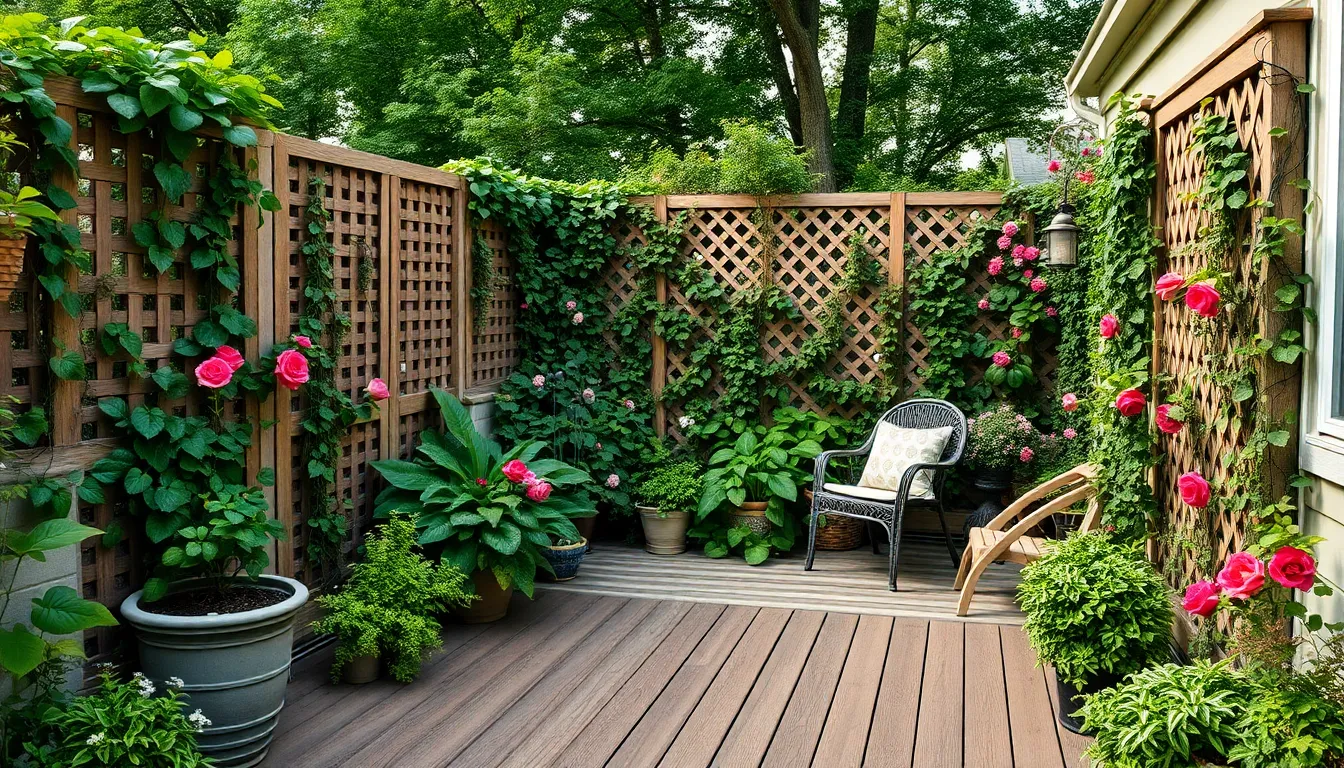
We can transform our garden decking into intimate outdoor sanctuaries by incorporating thoughtful privacy answers that enhance both functionality and aesthetic appeal.
Build Privacy Screens with Integrated Planters
Privacy screens become versatile design elements when we combine them with integrated planters. These dual-purpose structures create effective barriers while adding natural beauty to our outdoor spaces. We fill the planters with climbing plants like ivy or jasmine, shrubs such as boxwood or lavender, or seasonal hedges that provide year-round coverage.
Benefits include enhanced visual interest through layered textures and colors, plus a natural appearance that blends seamlessly with garden landscapes. Maintenance remains straightforward since we can easily access both the screen structure and plant containers for routine care. The integrated design eliminates the need for separate planter installations while maximizing our deck’s square footage.
Installation involves mounting sturdy frames that support both the privacy panels and integrated planter boxes. We select weather-resistant materials like composite lumber or treated cedar to ensure longevity. Drainage systems within the planters prevent water damage to the decking below while keeping our plants healthy throughout changing seasons.
Add Lattice Panels for Climbing Plants
Lattice panels offer classic privacy answers that pair beautifully with climbing vegetation. We install these decorative screens to create natural barriers while maintaining airflow around our deck space. Climbing plants like roses, clematis, or morning glories grow through the lattice openings, providing coverage that evolves throughout the growing season.
Advantages include a charming, rustic appearance with minimal ongoing upkeep requirements. The open lattice design allows breezes to flow freely while filtering harsh sunlight and unwanted views. We customize panel heights and widths to match our exact privacy needs and deck dimensions.
Installation requires secure mounting to deck railings or dedicated posts for stability. We choose pressure-treated lumber or vinyl lattice materials that withstand weather exposure. Spacing between lattice strips should accommodate our chosen climbing plants while providing adequate support as vegetation matures.
Design Strategic Deck Placement for Natural Privacy
Strategic positioning creates natural privacy without additional construction or materials. We align our decking to take advantage of existing industry features like mature trees, established hedges, or natural terrain variations. This approach blocks direct sight lines from neighboring properties while maximizing our garden’s inherent beauty.
Planning involves surveying our property to identify natural barriers and optimal deck locations. We position elevated sections behind existing shrubs or align deck edges with tree canopies for enhanced screening. Sloped areas can accommodate multi-level designs that create privacy through elevation changes rather than vertical barriers.
Benefits include reduced construction costs and minimal environmental impact since we’re working with established industry elements. Natural features provide immediate privacy that would take years to achieve with newly planted screens. We also preserve our garden’s existing character while creating secluded outdoor living areas that feel integrated rather than imposed upon the industry.
Conclusion
We’ve explored countless ways to transform your garden with innovative decking answers that blend functionality with style. From multi-level designs that maximize space to sustainable material choices that protect your investment these ideas offer something for every outdoor space and budget.
The key to successful garden decking lies in thoughtful planning that considers your exact needs lifestyle and existing industry features. Whether you’re drawn to built-in storage answers atmospheric lighting or privacy screens with integrated planters each element should work together to create a cohesive outdoor living experience.
Your garden deck can become the heart of your outdoor entertainment space – a place where memories are made and relaxation comes naturally. With the right combination of materials features and design elements you’ll create an outdoor sanctuary that enhances both your property value and quality of life for years to come.
Frequently Asked Questions
What are the main benefits of adding garden decking to my outdoor space?
Garden decking increases property value while creating versatile spaces for relaxation and socializing. It transforms unusable areas into functional outdoor rooms, works well in both small city gardens and large countryside settings, and provides a stable platform for dining, entertaining, and enjoying nature regardless of your garden’s size or terrain.
How do multi-level deck designs enhance outdoor spaces?
Multi-level decking creates visual interest and natural boundaries by incorporating different heights and elevations. This design approach is particularly effective in sloped gardens, adding architectural dimension while creating distinct activity zones. Proper planning of transitions between levels and strategic placement of built-in planters helps soften edges and enhance privacy.
Which decking material offers the best value for money?
Composite decking typically offers the best long-term value despite higher upfront costs. It requires minimal maintenance, resists weathering and damage, and provides significant savings over time. While natural wood options like cedar offer beauty and durability, composite materials eliminate the need for regular staining, sealing, and replacement.
Can I integrate existing garden features into my deck design?
Yes, designing around existing features enhances your garden’s natural character. Build decking that encircles mature trees, complements existing plants, and works with your garden’s natural slope. Incorporating natural stone elements like pathways and borders adds texture while creating seamless integration between your deck and existing landscape.
What built-in features can maximize my deck’s functionality?
Corner bench seating with storage compartments, integrated planter benches, and custom storage boxes that double as seating maximize space efficiency. These features create intimate conversation areas while providing practical storage solutions. Use weather-resistant materials and include features like soft-close hinges and ventilation to ensure durability.
How can I make my deck usable during evening hours?
Install LED strip lighting along deck edges for safety and ambiance, add solar-powered post lights for eco-friendly illumination, and string lights for cozy atmosphere. These lighting solutions enhance safety while creating inviting spaces for nighttime gatherings and relaxation without requiring complex electrical work.
Can I incorporate water features into my deck design?
Absolutely! Design decking around garden ponds following natural contours, add deck-mounted fountains for visual appeal and soothing sounds, or create raised platforms around hot tubs. Include built-in benches and safety railings for comfort. Plan for electrical and plumbing access during the design phase for seamless integration.
What overhead structures work best with garden decking?
Retractable awning systems offer flexible sun control, traditional wooden pergolas create focal points and support climbing plants, while modern sail shade structures provide contemporary elegance with excellent UV protection. Choose based on your style preferences, budget, and desired level of sun protection and weather resistance.
How can I create privacy on my deck without blocking natural light?
Use privacy screens with integrated planters, install lattice panels that support climbing plants for natural barriers while maintaining airflow, and strategically place your deck to utilize existing natural features. These solutions enhance privacy while preserving your garden’s character and reducing construction costs.

